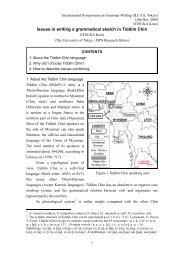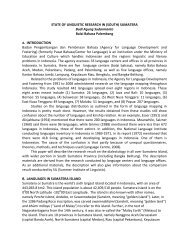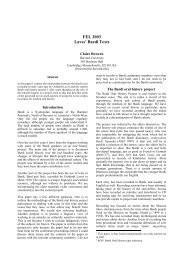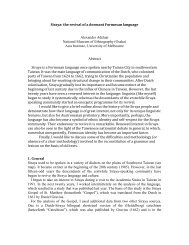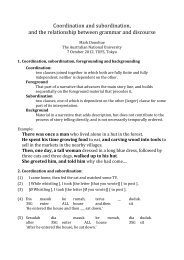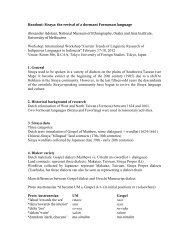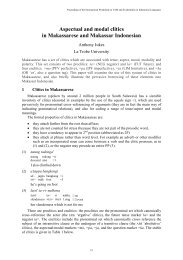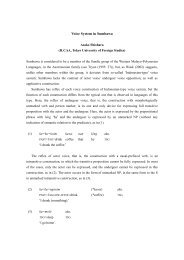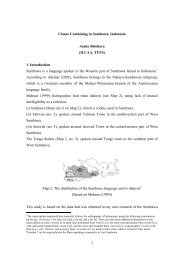Issues in writing a grammatical sketch of the Burushaski language
Issues in writing a grammatical sketch of the Burushaski language
Issues in writing a grammatical sketch of the Burushaski language
Create successful ePaper yourself
Turn your PDF publications into a flip-book with our unique Google optimized e-Paper software.
10/DEC/2009<br />
International Symposium on Grammar Writ<strong>in</strong>g<br />
<strong>Issues</strong> <strong>in</strong> writ<strong>in</strong>g a <strong>grammatical</strong> <strong>sketch</strong> <strong>of</strong> <strong>the</strong> <strong>Burushaski</strong> <strong>language</strong><br />
YOSHIOKA Noboru<br />
(Tokyo University <strong>of</strong> Foreign Studies)<br />
1. About <strong>the</strong> <strong>Burushaski</strong> <strong>language</strong><br />
<strong>Burushaski</strong> 1 is a <strong>language</strong> isolate<br />
spoken <strong>in</strong> a part <strong>of</strong> <strong>the</strong> Nor<strong>the</strong>rn Areas<br />
<strong>of</strong> Pakistan by 60–100,000 people.<br />
Typologically, <strong>Burushaski</strong> is a<br />
typical agglut<strong>in</strong>ative <strong>language</strong>, and it<br />
employs a certa<strong>in</strong> number <strong>of</strong> prefixes, a<br />
lot <strong>of</strong> suffixes, and a few enclitics. The<br />
nouns <strong>in</strong> <strong>Burushaski</strong> are classified <strong>in</strong>to<br />
four noun classes: HM, HF, X, and Y. HM<br />
is <strong>the</strong> class for human-male entities, HF<br />
is for human-female entities, X is for<br />
concrete th<strong>in</strong>gs <strong>in</strong>clud<strong>in</strong>g animals and<br />
Figure 1. Map <strong>of</strong> Pakistan<br />
fruits, and Y is for abstract th<strong>in</strong>gs<br />
<strong>in</strong>clud<strong>in</strong>g liquids, notions and trees. The basic word order <strong>of</strong> <strong>Burushaski</strong> is SOV, but <strong>the</strong> order is not<br />
so rigid.<br />
2. How my study has developed<br />
I started <strong>the</strong> study on <strong>Burushaski</strong> out <strong>of</strong> curiosity <strong>in</strong> 2003.<br />
Learn<strong>in</strong>g Urdu <strong>in</strong> a undergraduate program => Study<strong>in</strong>g <strong>Burushaski</strong> <strong>in</strong> a master/doctoral course<br />
Firldwork:<br />
5 times (total 6 months); <strong>in</strong> <strong>the</strong> Hunza, Nager, and Yas<strong>in</strong> valleys / ma<strong>in</strong>ly <strong>in</strong> Karimabad, Hunza<br />
morphology <strong>of</strong> <strong>the</strong> variable suffixes for plural mark<strong>in</strong>g<br />
=> morphophonology <strong>of</strong> so-called ‘echo words’<br />
==> morphology <strong>of</strong> Hunza <strong>Burushaski</strong> [M.A. <strong>the</strong>sis <strong>in</strong> 2007]<br />
===> now, a descriptive grammar <strong>of</strong> Eastern <strong>Burushaski</strong> (Hunza-Nager <strong>Burushaski</strong>) [for Ph.D.]<br />
I have met some worry<strong>in</strong>g issues <strong>in</strong> writ<strong>in</strong>g a <strong>grammatical</strong> skecth <strong>of</strong> <strong>Burushaski</strong>. I don’t know<br />
yet what to do about <strong>the</strong>se issues. So I show <strong>the</strong> one <strong>of</strong> <strong>the</strong>m here.<br />
3. How do we give a name to an unfamiliar functional category<br />
There are two types <strong>of</strong> person-number-class agreement on verbs <strong>in</strong> <strong>Burushaski</strong>.<br />
1 Phonologically, <strong>Burushaski</strong> has 5 vowels /i, e, a, o, u/ and 36 consonants /p, ph[pʰ], b, t[t̪], th, d,<br />
ṭ[ʈ], ṭh, ḍ, k, kh, g, q, qh, c[ʦ], ch, č[ʨ], čh, j[ʥ], c̣[ʈʂ], cḥ, j̣[ɖʐ], s, z, š[ɕ], ṣ[ʂ], γ, h, w, y[j], ỵ[ɰ̟], m,<br />
n, ŋ, r[ɾ], l/. Vowels have <strong>the</strong> opposition between short and long. <strong>Burushaski</strong> employs a pitch-accent<br />
system, every word has one high-pitched accent as a rule. I represent accented vowels with an acute<br />
accent mark (ˊ).<br />
1
(−4) (−3) (−2) (−1) 0 (+1) (+2) (+3) +4 (+5)<br />
negative personal prefix root aspect modality/auxiliary<br />
telicity causative plurality personal suffix person/modality<br />
Figure 2. Verbal template <strong>in</strong> <strong>Burushaski</strong><br />
0 (+1) (+2)<br />
stem<br />
reality<br />
personal suffix<br />
Figure 3. Auxiliary copular template <strong>in</strong> +4 slot <strong>in</strong> verbs <strong>of</strong> <strong>Burushaski</strong><br />
Agreement <strong>in</strong> +3/+5 slots <strong>of</strong> verbs and <strong>in</strong> +1 slot <strong>of</strong> auxiliary copulas is triggered by <strong>the</strong> subject<br />
<strong>of</strong> clause (+3 is only for <strong>the</strong> 1st person plural with imprefect aspect and <strong>the</strong> 1st person s<strong>in</strong>gular; +5 is<br />
for <strong>the</strong> rest). The personal suffix agrees with <strong>the</strong> absolutive argument <strong>in</strong> <strong>in</strong>transitive clauses; though<br />
it agrees with <strong>the</strong> ergative argument <strong>in</strong> transitive and ditransitive clauses.<br />
Some <strong>of</strong> verbs need <strong>the</strong> personal agreement prefix <strong>in</strong> <strong>the</strong> stem. The personal prefix <strong>of</strong> −2 slot<br />
marks <strong>the</strong> person-number-class <strong>of</strong> ei<strong>the</strong>r <strong>the</strong> absolutive argument <strong>in</strong> (<strong>in</strong>volitional) <strong>in</strong>transitive, and<br />
transitive clauses, or <strong>the</strong> dative argument <strong>in</strong> ditransitive clauses.<br />
(1) éḍ dáa phikarmánd imánimi.<br />
éḍ-Ø dáa phikarmánd i-́ man -Ǿ -m -i<br />
Ed-ABS and worried 3SG.HM- become -PF -IRR -3SG.HM<br />
[ −2 0 +2 +4 +5 ] V<br />
‘Ed got worried aga<strong>in</strong>.’ (uyúm daγánum búšan: #92)<br />
(2) íne icé šurómuc dósmai bái<br />
ín-e icé šuró-muc-Ø d-́ u-̇ s- man -́č +bá -i -Ø<br />
he:DIS-ERG those:X pie-PL-ABS TEL- 3PL.X- CAUS- become -IMPF +COP:H -3SG.HM -RE<br />
[ −3 −2 −1 0 +2 +4 [ +1 +2 ] AUX ] V<br />
[ −3 −2 −1 0 +2 [ 0 +1 +2 ] AUX<br />
‘he is bak<strong>in</strong>g <strong>the</strong> pies’ (uyúm daγánum búšan: #11)<br />
(3) “zarúur, maγóyam,” flem<strong>in</strong>góoe teí nusén icéer búṭan<br />
zarúur ma-́γon-́č-a-m flem<strong>in</strong>góo-e teí n-śén icé-ar búṭ-an<br />
necessary 2PL-give:PL.Y.OBJ-IMPF-1SG-IRR flam<strong>in</strong>go-ERG such SEQ-say those:X-DAT much-EMP<br />
asqúriŋ<br />
uγónimi.<br />
asqúr-iŋ-Ø u-́ γon -Ǿ -m -i<br />
flower(Y)-PL-ABS 3PL.X- give:PL.Y.OBJ -PF -IRR -3SG.X<br />
[ −2 0 +2 +4 +5 ] V<br />
‘ “Of course, I’ll give you,” said <strong>the</strong> flam<strong>in</strong>go, and it gave <strong>the</strong>m lots <strong>of</strong> flowers.’ (uskó jóṭišo<br />
urkái ke uyúm γuníkiṣ qhúuq: #40)<br />
2
Now, I cite here <strong>the</strong> major ditransitive alignment types from Haspelmath 2005 (it seems based<br />
on Dryer 1986); <strong>the</strong>re are three types <strong>of</strong> alignment are assumed <strong>in</strong> respect <strong>of</strong> <strong>the</strong> relationship among<br />
Patient-like argument, Theme-like argument, and Recipient-like argument.<br />
P<br />
T<br />
R<br />
directive <strong>in</strong>directive<br />
a. <strong>in</strong>directive alignment<br />
T<br />
P<br />
R<br />
b. neutral alignment<br />
P<br />
T<br />
R<br />
secundative primative<br />
c. secundative alignment<br />
Figure 4. The major ditransitive alignment types (Haspelmath 2005: 2)<br />
As for mono- and di-transitive verb stems <strong>in</strong> <strong>Burushaski</strong>, <strong>the</strong> personal prefix agrees with <strong>the</strong><br />
primative (object) argument as illustrated <strong>in</strong> Figure 6.<br />
-Ø<br />
-Ø -ar<br />
directive<br />
<strong>in</strong>directive<br />
Figure 5. Indirective flagg<strong>in</strong>g <strong>in</strong> <strong>Burushaski</strong><br />
personal prefix<br />
none<br />
personal prefix<br />
secundative<br />
primative<br />
Figure 6. Secundative <strong>in</strong>dex<strong>in</strong>g <strong>in</strong> <strong>Burushaski</strong><br />
But <strong>the</strong> personal prefix can co-occur even with <strong>in</strong>transitive stems as shown with example (1). Please<br />
see Table 1, I <strong>in</strong>dicate <strong>the</strong> worry<strong>in</strong>g po<strong>in</strong>t with question marks here.<br />
Table 1. Index<strong>in</strong>g and flagg<strong>in</strong>g systems <strong>in</strong> <strong>Burushaski</strong><br />
<strong>in</strong>dex<strong>in</strong>g<br />
type <strong>of</strong> clause<br />
flagg<strong>in</strong>g<br />
personal prefix persosnal suffix<br />
<strong>in</strong>tr. ABSOLUTIVE ABS<br />
ABSOLUTIVE<br />
tr.<br />
SUBJECT<br />
PRIMATIVE ERGATIVE<br />
ditr.<br />
DATIVE<br />
ABS, ERG<br />
ABS, ERG, DAT<br />
Abbreviations<br />
ABS absolutive<br />
AUX auxiliary (copula)<br />
CAUS causative<br />
COP copula<br />
DAT dative<br />
DIS distal<br />
EMP emphasis<br />
ERG ergative<br />
HM H(uman)M(ale)-class<br />
IMPF<br />
IRR<br />
OBJ<br />
P<br />
PF<br />
PL<br />
R<br />
RE<br />
SEQ<br />
imperfect<br />
irrealis<br />
object<br />
patient-like argument<br />
perfect<br />
plural<br />
recipient-like argument<br />
realis<br />
sequential<br />
SG s<strong>in</strong>gular<br />
T <strong>the</strong>me-like argument<br />
TEL telic<br />
V verb<br />
X X-class<br />
Y Y-class<br />
1 first person<br />
2 second person<br />
3 third person<br />
Reference<br />
Haspelmath, Mart<strong>in</strong>. 2005. Argument mark<strong>in</strong>g <strong>in</strong> ditransitive alignment types. L<strong>in</strong>guistic Discovery,<br />
3/1: 1-21.<br />
3



